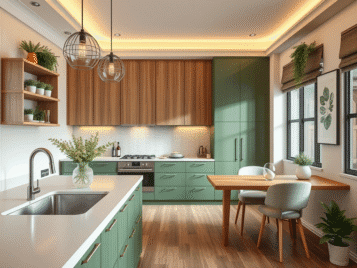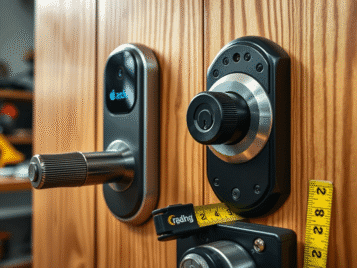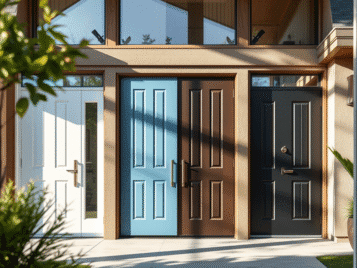Indian homeowners love the warmth of timber, yet many worry about warping, termites, and rising carpentry costs. High‑pressure laminate (HPL) skins offer a practical answer: they protect the wood, expand design options, and cut maintenance in half. When done right, an HPL‑clad door feels like solid timber but performs like a modern composite. Let’s explore how to blend the two materials—drawing on SamratHPL’s experience supplying both architectural plywood and decorative laminates across the country.
1. Why Combine HPL and Solid Wood?
Strength Meets Style
- Dimensional stability – A solid‑wood frame provides rigidity, while the HPL surface shields against humidity swings.
- Design freedom – Laminate prints and textures go far beyond what natural timber alone can offer, from exotic veneers to matte cement looks.
- Cost control – A engineered core plus HPL skin costs less than thick hardwood but still feels premium.
2. Choosing the Right Frame Timber
Even the best laminate can fail if the core moves. Samrat carpentry teams typically recommend:
| Timber species | Key advantage | Typical use |
|---|---|---|
| Teak or White Ash | High natural oil content fights moisture | Main door frames |
| Red Meranti | Affordable, stable when kiln‑dried | Internal room frames |
| Rubberwood | Eco‑friendly plantation timber | Wardrobe shutters |
Tip: Ask the sawmill for moisture content below 12 %. Anything higher invites shrinkage later.
3. Selecting the Perfect HPL Skin
Thickness Matters
SamratHPL offers laminates in 0.8 mm, 1 mm, and 1.2 mm gauges. For doors, aim for 1 mm or thicker—thinner sheets risk telegraphing grain patterns from the substrate.
Finish Choices
- Textured woodgrains mimic oak, walnut, or wenge without the upkeep.
- Suede mattes give a modern, fingerprint‑resistant surface for high‑traffic homes.
- Metallic or stone prints transform ordinary frames into statement pieces.
4. Bonding Techniques That Last a Decade
- Factory Pressing
Large projects often send the plywood core to Samrat’s hot‑press line. Consistent heat and pressure drive adhesive deep into the board, eliminating bubbles. - Cold Press with D3 Glue
Small sites can cold‑press on a work bench. Use a urea‑based D3 adhesive, roller‑spread evenly at 150 g / sq m. Clamp for a minimum of two hours. - Edge Lipping Before Lamination
Seal all four edges of the frame with hardwood strips. This stops moisture wicking into the core and prevents the dreaded “edge swell.”
5. Colour Harmony: Frame vs Skin
Designers at Samrat suggest two routes:
- Seamless Match – Pick a laminate that mirrors the frame’s stain. The door appears carved from a single slab.
- Bold Contrast – Pair a dark walnut frame with a light concrete laminate for a gallery‑like focal point. Balance the contrast with matching skirting or wall panels nearby.
6. Hardware Dos and Don’ts
- Concealed Hinges – Ensure the hinge cup depth suits the laminate thickness; oversize drilling can crack the HPL.
- Screw Choice – Stainless‑steel screws resist rust where the hinge meets the frame. Pre‑drill pilot holes to avoid splitting.
- Locks – Mortise locks sit flush inside the frame. Use a router jig so the laminate edges stay crisp, not chipped.
7. Finishing Touches and Maintenance
- Seal the Bottom Edge – A quick coat of polyurethane stops mop water from creeping upward.
- Quarterly Dust Wipe – Laminate needs only a soft cloth; skip abrasive pads.
- Annual Hinge Check – Tighten screws; minor play can stress both wood and HPL over time.
8. Typical Cost Breakdown (Delhi NCR, mid‑2025)
| Component | Average rate (₹/sq ft) |
|---|---|
| Solid‑wood frame (Meranti) | 140–180 |
| BWP plywood core | 90–120 |
| 1 mm SamratHPL decorative laminate | 100–140 |
| Adhesive & pressing | 25–35 |
| Hardware set | 70–150 |
A full‑height door generally runs 6.5–7 sq ft, putting the finished cost between ₹2,800 and ₹3,900, depending on timber species and hardware grade.
9. Common Pitfalls—and How to Avoid Them
- Skipping edge lipping – Exposed plywood edges suck up humidity first.
- Uneven glue spread – Creates voids that eventually show as surface ripples.
- Over‑tight screws – Can crack hardwood lipping and loosen the laminate face.
The Final Word
A well‑paired HPL skin on a solid‑wood frame delivers the best of both worlds: the charm of timber and the resilience of modern technology. SamratHPL’s broad laminate palette and engineered plywood cores make the process straightforward—no guesswork, no squeaks, no warping through the monsoon. Plan your frame, pick a matching or contrasting skin, and bond them with care. Done right, you’ll swing open a door that feels luxurious today and still looks fresh a decade later.


